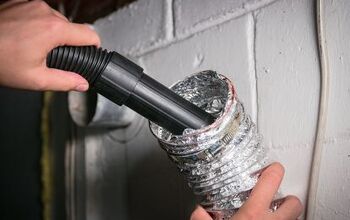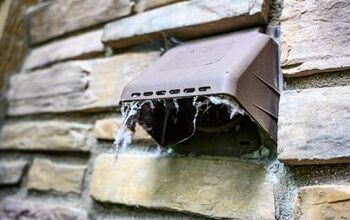How Much Does A Dryer Weigh? (Find Out Now!)

Are you looking to get a new dryer for your home? Or is your old dryer just not cutting it anymore? If this is the situation, you may wonder how much does a dryer weighs to move it out of the home.
Most dryers weigh around 124 pounds. A dryer’s weight depends on different factors.
- The type of dryer
- The capacity of clothes the dryer will hold
- The features the dryer has
- The brand of the dryer
Smaller dryers can weigh only 100 pounds, while more oversized dryers can weigh up to 200 pounds.
The most significant factor that affects the weight of a dryer is the capacity that the dryer can hold. Whether the dryer is still active or being sold for scrap metal, the capacity helps with the weight.
What to Remember When Purchasing a Dryer
We recommend that before you buy a dryer, you take these things into account
1. What Dryer Fits Into My Budget
More oversized dryers that have more features and come from higher-end brands typically cost more money.
2. How Much Space You Have
Make sure to get a dryer that is the right size for the space that you have.
3. How Big Are Your Laundry Loads
For smaller loads, there isn’t a reason to get a 200-pound dryer with a large capacity. If you are drying clothes for a whole family, it might be worth getting a larger dryer.
Electric vs. Gas Dryers
Dryers these days are either fully powered electrically or powered partially by gas. Either way, electricity is used for tumbling clothes in the dryer.
Electric Dryers
- It is heated directly by electricity that blows warm air into the dryer.
- It is easy installation. All that you need is a 240-volt outlet.
- Electric dryers usually cost less upfront but use more electricity in the long run.
Gas Dryers
- Heated by natural gas blowing into the dryer.
- The installation process is more complicated. Gas dryers require a natural gas line along with a 120-volt outlet
- Gas dryers cost more upfront but will use less electricity in the long run.
Features Most Electric Dryers Have
It is rare to find heavy differences between the old to the new models. Most of the differences lie in the technology and digital age. Below are notable features found on electric dryers, both old and new.
Dial or Digital
Inexpensive dryers will come with a large dial to decide the heat setting you want with an on/off button. There won’t be a dial on newer and higher-end dryers, but all digital on a screen. Neither one is “better” than the other.
Timed Heat
A timed heat setting is found on most electric dryers. This setting allows you to decide how long you would like your clothes to dry.
Moisture Sensor
This feature tells the dryer how much moisture is in the dryer based on how wet the laundry is. This sensor will adjust drying times based on the wetness of clothes. This will help to save energy and decrease wear and tear on the dryer and the clothes.
Delicate Setting
Electric dryers will have a delicate setting. This setting is a low heat setting that is good for soft fabrics.
Interchangeable door
Most electric dryers give you the option to hinge the door on either the left or right of the dryer.
6 Advanced Features Electric Dryers Have
Many of the modern-day models have these advanced features you see below. They have made laundry a little more enthusiastic.
- Drying Rack. Some more expensive dryers will come with a drying rack.
- Steam Feature. An advanced feature that helps prevent wrinkles.
- Sanitizing Setting. This advanced setting is a high heating setting that helps to kill bacteria in the laundry.
- Detangle. The feature causes the dryer to switch directions near the end of a cycle to detangle clothes or sheets.
- Express Dry Setting. This advanced setting blows more hot air in at a quicker pace to help dry clothes faster.
- Wrinkle Shield. Sometimes you cannot take your clothes out of the dryer right away after the load is finished. This setting causes the dryer to tumble periodically, keeping wrinkles at a minimum.
Cost of An Electric Dryer
An electric dryer will cost you anywhere from $300 to $1,100, depending on the features. On the low end are your basic dryers. The more expensive dryers are usually some with more advanced features.
Some of these advanced features include energy efficiency and the advanced features listed above. Most people will fall in the range of a $500 to $700 dryer. With these, you will get a dryer with some bells and whistles of the more expensive models.
Tips About Using a Dryer
- Make sure not to overload the dryer. If the dryer is overloaded, it will take longer than a normal cycle to dry your clothes. We recommend that you fill the drum halfway to three-quarters.
- If you shake out your clothes before putting them in the dryer, it will help prevent wrinkles.
- Use low heats for delicate fabrics, dress clothes, and clothes high in cotton to prevent shrinking.
- Use high heats for towels, bedsheets, and heavy clothing like jeans
- Make sure not to add wet clothing to a partially dried load. If you do, this might affect the moisture sensor and waste additional energy.
- If it is avoidable, try not to open the door before the load is done. If you do, heat will escape and waste energy.
- To prevent wrinkles, remove your load of laundry right when it is completed drying.
- Make sure to clean the lint out of the lint trap after every load.
- Clean out the back hoses in the machine at least once a year.
Sound Advice on Moving a Washer and Dryer
Washers and dryers are heavy and clunky, so moving them can be difficult. Below are some steps to take to help you move your washer and dryer out of your house.
1. Clean Everything
Most washers have a self-clean cycle. We recommend that you do this before moving. We recommend wiping it down with a Clorox wipe or any other sanitary wipe you might use for your dryer. While doing that, also make sure the lint trap is cleaned.
2. Get Your Moving Equipment and Supplies
We recommend you get these supplies for the easiest moving method. Grab the furniture blanket, moving tape, an appliance dolly, and moving straps.
3. Turn Off the Circuit Breaker Panel for That Room
Before you start unplugging things, you should turn off the circuit breaker to that room. This is a safety measure that is mandatory to avoid electrocution.
4. Unplug the Washer and Dryer
Before moving your appliances, make sure that all the cords, tubes, vents, and pipes have been disconnected. If you are not sure of how to do this correctly or are unconfident in your ability, we recommend calling a professional. It will cost you a little more money, but they will be able to get it done quickly.
5. Connect the Transit Bolts to the Washer
Before moving the washer, it’s critical to secure the drum in the washer. If you do not, you might cause damage to the washer when moving because the drum will move freely. To do this, you will connect the transit bolts to the washer.
Every washer comes with transit bolts, so we recommend looking at your washer’s instruction guide to connect the transit bolts.
6. Tape the Loose Cords
Tape loose cords down to prevent injury and damage to the home.
7. Wrap Everything With Furniture Pads
This is another step that will help protect against damages to your home.
8. Create a Plan
Decide the route of moving the washer and dryers out. We recommend that you measure doors and hallways to make sure the dryer will fit. If you need an extra inch through a doorway, take the door off.
9. Ask a Friend to Help
Because washers and dryers are heavy objects, we recommend that you ask a friend to help. This is not a one-person job, and at the least, you need a spotter to help you move the appliances.
10. Move the Equipment with a Dolly
The easiest and safest way to move these larger appliances is with a dolly. We do not recommend lifting as this can cause strain or injury. One person pushes the dolly while the other spots it to make sure it does not fall or hit anything.
If you are not looking to move your washer or dryer on your own, there is the option of hiring professional movers. Almost every appliance retailer has a professional moving team. They are trained and know how to handle moving appliances with care.
Usually, this cost will depend on the weight of what is being moved or how many hours it takes to move it. The main factor on price is by doing it safely and efficiently. Everyone knows it is not good to get injured.

We are a team of passionate homeowners, home improvement pros, and DIY enthusiasts who enjoy sharing home improvement, housekeeping, decorating, and more with other homeowners! Whether you're looking for a step-by-step guide on fixing an appliance or the cost of installing a fence, we've here to help.
More by Upgraded Home Team
























![Cost To Drill A Well [Pricing Per Foot & Cost By State]](https://cdn-fastly.upgradedhome.com/media/2023/07/31/9074980/cost-to-drill-a-well-pricing-per-foot-cost-by-state.jpg?size=350x220)

![10 Most Dangerous Neighborhoods in Baltimore [Updated]](https://cdn-fastly.upgradedhome.com/media/2023/07/31/9075655/10-most-dangerous-neighborhoods-in-baltimore-updated.jpg?size=350x220)
